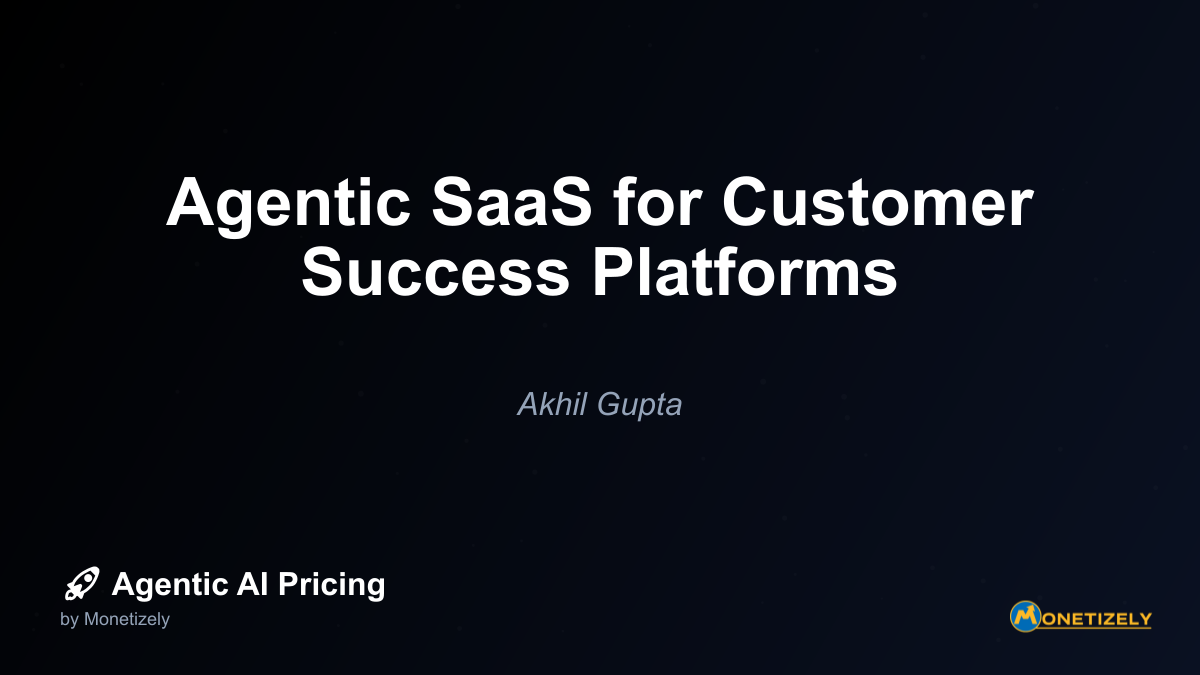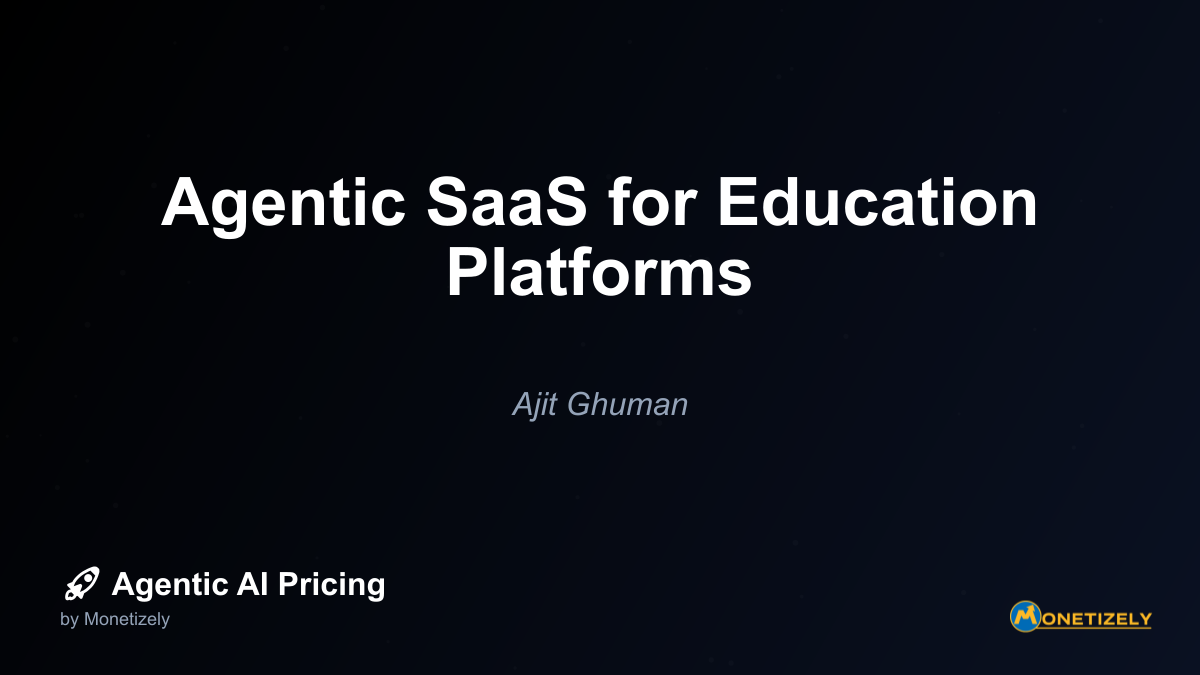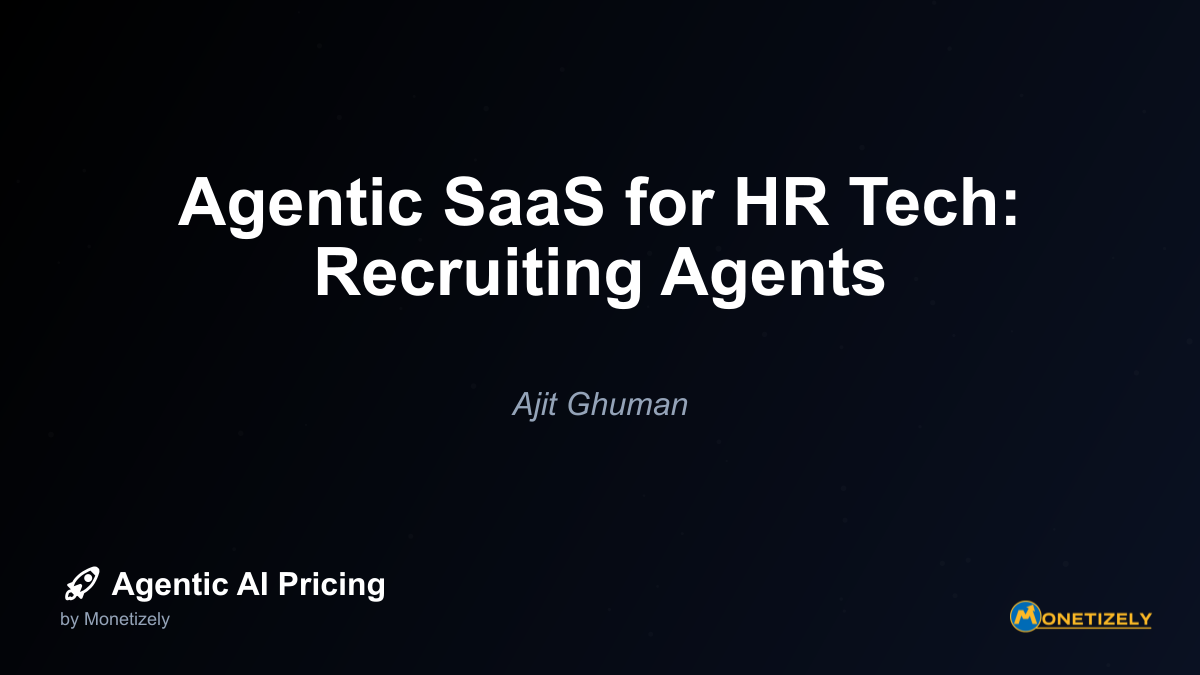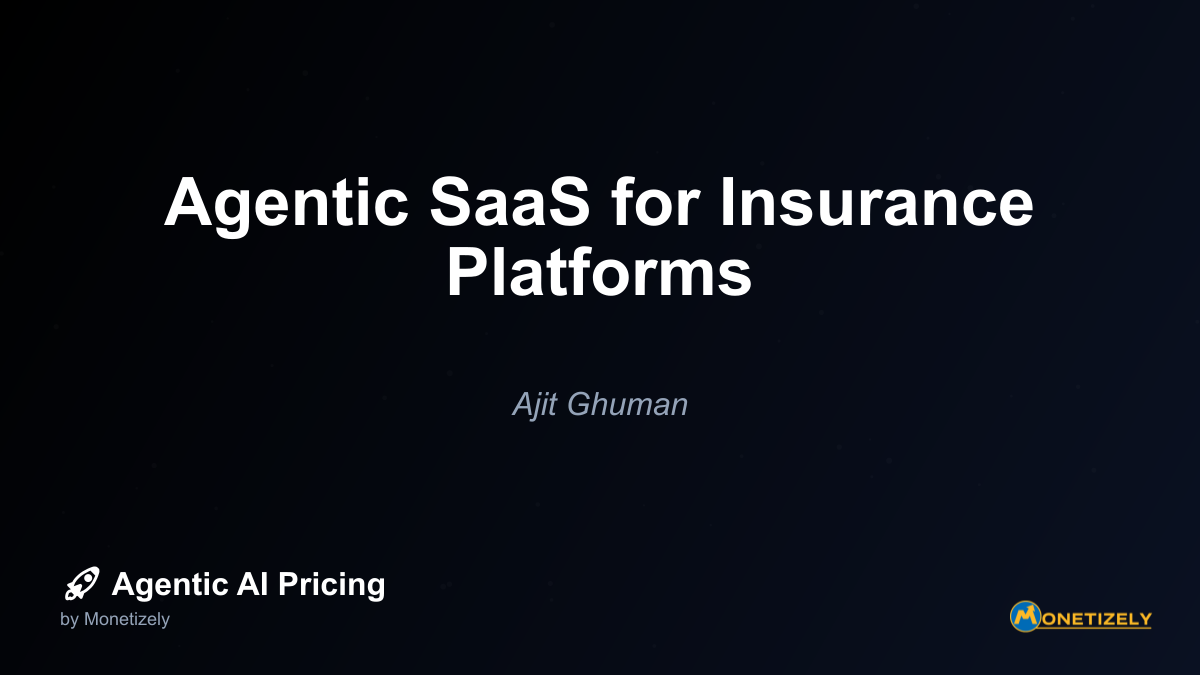· Akhil Gupta · Vertical Applications · 7 min read
Agentic SaaS in Retail Tech
AI and SaaS Pricing Masterclass
Learn the art of strategic pricing directly from industry experts. Our comprehensive course provides frameworks and methodologies for optimizing your pricing strategy in the evolving AI landscape. Earn a professional certification that can be imported directly to your LinkedIn profile.
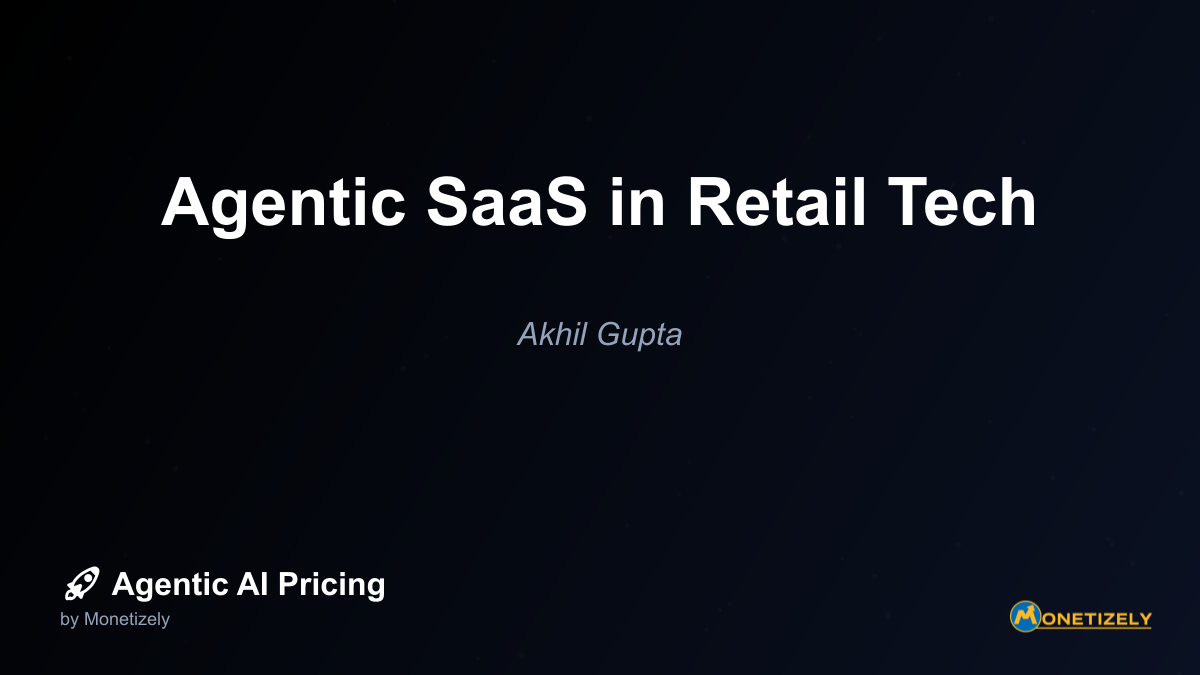
A mid-sized regional supermarket chain with 78 stores across three states provides an illustrative example of the transformative potential of agentic SaaS in retail. Facing increasing competition from national chains and e-commerce giants, the company implemented an integrated agentic solution for inventory and pricing optimization.
Pre-Implementation Challenges
Before adopting agentic technology, the supermarket chain faced several operational challenges:
- Inventory levels varied significantly across locations, with some stores experiencing frequent stockouts while others maintained excess inventory
- Pricing decisions were made centrally on a weekly basis, with limited ability to respond to local market conditions
- Promotions were scheduled months in advance with minimal data-driven evaluation of effectiveness
- Perishable goods represented a significant source of waste and lost revenue
The Agentic Solution
The company implemented a comprehensive agentic SaaS solution that integrated with their existing point-of-sale and inventory management systems. Key components included:
Inventory Optimization Agent: This system analyzed historical sales data, seasonality patterns, and local events to predict demand and suggest optimal inventory levels for each store. It also recommended stock transfers between locations to balance inventory across the network.
Dynamic Pricing Agent: Working within predefined guardrails, this agent adjusted prices based on inventory levels, competitor pricing, product freshness (for perishables), and local demand patterns. Price changes were automatically pushed to electronic shelf labels and the company’s mobile app.
Promotion Planning Agent: This component evaluated historical promotion performance and suggested optimal timing, discount levels, and product bundles to maximize revenue and minimize cannibalization of full-price sales.
Implementation Process
The implementation followed a phased approach:
- Pilot Phase (3 months): The solution was deployed in five stores, with careful monitoring and comparison against control stores.
- Limited Rollout (6 months): Based on successful pilot results, the system was expanded to 20 stores.
- Full Implementation (12 months): After refinement and staff training, the solution was deployed across all 78 locations.
Results and ROI
The agentic SaaS implementation delivered impressive results across multiple metrics:
- Inventory Optimization: Overall inventory levels decreased by 18% while product availability improved by 7%.
- Waste Reduction: Perishable waste decreased by 32%, representing annual savings of approximately $3.4 million.
- Pricing Optimization: Gross margins improved by 2.8 percentage points without significant impact on sales volume.
- Revenue Growth: Same-store sales increased by 4.2% compared to the pre-implementation period.
- ROI Timeline: The company achieved full return on investment within 14 months of complete deployment.
Most significantly, the supermarket chain reported improved competitive positioning in all markets, with particular strength in areas where national chains had previously dominated.
Pricing Models for Agentic SaaS in Retail
For retailers considering agentic SaaS solutions, understanding the available pricing models is crucial for evaluating potential return on investment. Several models have emerged in the agentic retail technology market:
Value-Based Pricing
Value-based pricing for agentic retail solutions ties the cost of the software to the measurable value it delivers. This model typically involves:
- Base subscription fee covering core functionality
- Performance-based component calculated as a percentage of documented savings or revenue increases
- Periodic value assessment to adjust fees based on realized benefits
This pricing approach aligns vendor and retailer incentives, as both parties benefit from improved performance. However, it requires robust measurement methodologies to accurately quantify the value delivered.
Tiered Functionality Pricing
Many agentic SaaS providers offer tiered pricing based on the scope of functionality:
- Basic Tier: Typically includes inventory optimization with limited autonomy and manual oversight requirements
- Standard Tier: Adds dynamic pricing capabilities with moderate autonomy and integration with electronic shelf labels
- Premium Tier: Provides fully autonomous inventory and pricing optimization with advanced promotional planning and multi-channel coordination
This model allows retailers to start with essential functionality and expand as they become comfortable with agentic technology.
Scale-Based Pricing
Scale-based pricing adjusts costs according to the retailer’s size and implementation scope:
- Number of store locations
- Transaction volume
- SKU count
- Revenue volume
This approach ensures that smaller retailers can access agentic technology at appropriate price points while larger enterprises pay commensurate with their scale of operations.
Hybrid Models
Many vendors combine elements of the above approaches into hybrid pricing models. A common structure includes:
- Base fee determined by retailer size and scale
- Functionality tiers that unlock additional capabilities
- Performance-based components for specific high-value features
These hybrid models provide flexibility to accommodate diverse retailer needs and risk preferences.
Future Trends in Agentic Retail Technology
The agentic SaaS landscape for retail continues to evolve rapidly. Several emerging trends are likely to shape the future of this technology:
Multi-Agent Ecosystems
Rather than single agents handling broad domains, future systems will likely feature specialized agents working in concert:
- Procurement agents negotiating with supplier systems
- Inventory agents managing stock levels across locations
- Pricing agents optimizing revenue and margins
- Marketing agents coordinating promotions with inventory and pricing
- Customer service agents personalizing shopping experiences
These specialized agents will communicate and coordinate their actions to optimize overall retail performance.
Enhanced Predictive Capabilities
Next-generation agentic systems will incorporate increasingly sophisticated predictive models:
- Long-range demand forecasting accounting for macroeconomic trends
- Early detection of emerging consumer preferences
- Prediction of competitive actions and optimal responses
- Supply chain disruption forecasting and mitigation planning
These enhanced predictive capabilities will enable more proactive rather than reactive management of inventory and pricing.
Cross-Channel Integration
As retail continues to embrace omnichannel strategies, agentic systems will evolve to seamlessly coordinate across channels:
- Unified inventory visibility and allocation across physical and digital channels
- Channel-specific pricing optimization that maintains overall brand integrity
- Cross-channel promotion coordination to prevent cannibalization
- Returns prediction and inventory rebalancing based on cross-channel purchase patterns
This integration will help retailers deliver consistent experiences while optimizing operations across all customer touchpoints.
Explainable AI and Transparent Decision-Making
As regulatory scrutiny of AI systems increases, agentic retail solutions will place greater emphasis on explainability:
- Clear documentation of decision factors influencing price changes
- Transparent inventory allocation rationales
- Audit trails for all autonomous actions
- Human-readable explanations of complex optimization decisions
These capabilities will help retailers maintain compliance while building trust in autonomous systems.
Implementation Roadmap for Retailers
For retailers considering agentic SaaS adoption, a structured implementation roadmap can significantly improve the likelihood of success:
Phase 1: Assessment and Preparation (2-3 months)
- Data Readiness Evaluation: Assess the quality, accessibility, and integration capabilities of existing data systems.
- Business Process Mapping: Document current inventory and pricing processes to identify automation opportunities.
- Success Metric Definition: Establish clear KPIs to measure the impact of agentic implementation.
- Stakeholder Alignment: Ensure buy-in from all relevant departments and leadership teams.
Phase 2: Vendor Selection and Solution Design (1-2 months)
- Vendor Evaluation: Compare available solutions based on functionality, integration capabilities, and pricing models.
- Solution Customization: Work with the selected vendor to tailor the solution to specific business requirements.
- Integration Planning: Develop detailed plans for connecting the agentic solution with existing systems.
- Change Management Strategy: Create a comprehensive plan for transitioning staff to new workflows.
Phase 3: Pilot Implementation (3-4 months)
- Limited Deployment: Implement the solution in a small subset of locations or product categories.
- Performance Monitoring: Closely track KPIs against control groups to measure impact.
- Iterative Refinement: Adjust agent parameters and business rules based on initial results.
- Staff Training: Begin training programs for employees who will interact with the system.
Phase 4: Full-Scale Deployment (6-12 months)
- Phased Rollout: Gradually expand implementation across all locations and product categories.
- Integration Completion: Finalize all system connections and data flows.
- Staff Enablement: Complete training programs and establish support resources.
- Performance Optimization: Continuously refine agent parameters to maximize results.
Phase 5: Continuous Improvement (Ongoing)
- Regular Performance Reviews: Conduct quarterly assessments of system performance against KPIs.
- Capability Expansion: Gradually increase agent autonomy as confidence in the system grows.
- Feature Adoption: Implement new capabilities as they become available from the vendor.
- Strategic Alignment: Ensure the agentic system continues to support evolving business objectives.
This structured approach helps retailers manage the complexity of agentic SaaS implementation while maximizing the probability of achieving desired business outcomes.
Conclusion
Agentic SaaS solutions for inventory and pricing optimization represent a significant advancement in retail technology. By leveraging autonomous AI agents to manage complex operational challenges, retailers can achieve unprecedented levels of efficiency, responsiveness, and profitability. The ability to dynamically adjust inventory levels and prices based on real-time data and sophisticated predictive models creates substantial competitive advantages in an increasingly challenging retail environment.
As with any transformative technology, successful implementation requires careful planning, stakeholder alignment, and a commitment to continuous improvement. Retailers that approach agentic SaaS adoption with a clear strategy and realistic expectations are well-positioned to realize significant returns on their investment.
The retail landscape will continue to evolve, with customer expectations and competitive pressures driving the need for ever more sophisticated technological solutions. Agentic SaaS represents not merely an incremental improvement in retail operations but a fundamental shift in how retailers approach inventory and pricing optimization. Those who embrace this shift early and effectively will likely find themselves at a significant advantage in the retail marketplace of tomorrow.
Co-Founder & COO
Akhil is an Engineering leader with over 16+ years of experience in building, managing and scaling web-scale, high throughput enterprise applications and teams. He has worked with and led technology teams at FabAlley, BuildSupply and Healthians. He is a graduate from Delhi College of Engineering and UC Berkeley certified CTO.
Pricing Strategy Audit
Let our experts analyze your current pricing strategy and identify opportunities for improvement. Our data-driven assessment will help you unlock untapped revenue potential and optimize your AI pricing approach.

